‘An Italian miracle’: Controversial Winter Olympics track slides into action
Sign up now: Get the biggest sports news in your inbox

Austria's Lisa Schulte during a test run on the new Cortina sliding track.
PHOTO: REUTERS
Follow topic:
CORTINA D’AMPEZZO – After many setbacks, controversies and only 13 months of construction, a feat hailed as “an Italian miracle”, the sliding track for the 2026 Milan-Cortina Winter Olympic Games was inaugurated on March 25.
Italy’s Mattia Gaspari may not be among the gold-medal favourites in the Dolomites from Feb 6 to 22 in 2026, but the 31-year-old skeleton specialist has already made history.
Gaspari, who was 14th at Beijing 2022, was the first to race down the much-discussed Cortina track as part of its pre-certification process to ensure its safety for competitors.
Until March 29, dozens of bobsleigh, luge and skeleton athletes will carry out a series of test runs over the 1,749 metres and 16 turns where speeds can hit 140kmh.
When construction work began in February 2024, late for a project of this scale and complexity, many doubted that it could be completed.
Not Mr Matteo Salvini, the second-in-command and Minister of Transport in Ms Giorgia Meloni’s government.
He relaunched the project at the end of 2023, when the organisers wanted to relocate the 12 bobsleigh, luge and skeleton events to neighbouring Austria or Switzerland, because of the lack of a functioning track in Italy.
“I want to thank the workers who came from all over the world to Cortina to create this miracle that represents Italy so well,” the Italian deputy premier said.
“Where there’s a will, there’s a way. Italian engineers and architects are without equal in the world,” added Mr Salvini, comparing the sliding track to Filippo Brunelleschi’s famed 15th-century dome over Florence Cathedral.
“History is full of Italians who dared. At the time, it was said of this dome that it would never last. Six centuries later, it’s still there. This will also apply to those who say these Olympic Games are too expensive.”
Perhaps to appease those worried about its future after the Olympics, the President of the Veneto region, Mr Luca Zaia, hailed the track – the first in the world, its promoters say, to use glycol rather than ammonia for its refrigeration – as “our Guggenheim Museum”.
“People will come to see a great achievement in terms of architecture and engineering,” he said.
Local conservation groups had expressed anger over both the track’s environmental impact and its use after the Olympics, as bobsleigh, luge and skeleton are sports with few participants in Italy.
The final work – changing rooms, start and finish areas – will be completed by November.
The sliding centre will have cost €118 million (S$170.4 million), while the budget for the Games is €5 billion, including €3.5 billion for the construction and renovation of sports venues and transport infrastructure.
“Building a track in 305 days has never been done before,” said Ivo Ferriani, president of the International Bobsleigh and Skeleton Federation (IBSF), noting that the average construction time for such a venue is 700 days.
“To be honest, I never really doubted, myself. It was a huge challenge, but we managed to turn a problem into a model,” said the Italian IBSF director.
“It’s an incredible feeling to go down this track,” added Italian bobsleigher Patrick Baumgartner.
“I’ve been doing this sport for 15 years, and this is the first time I’ve piloted on a track in Italy, at home.” AFP

